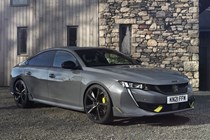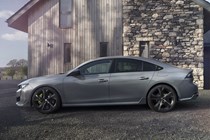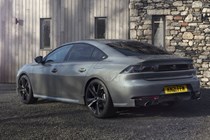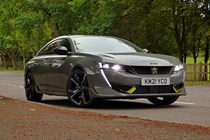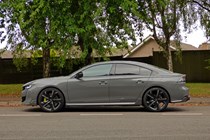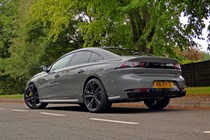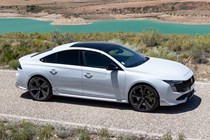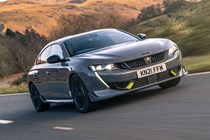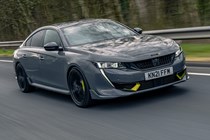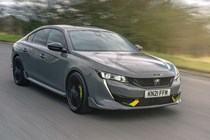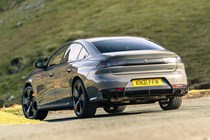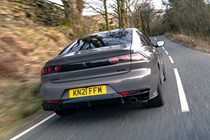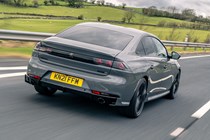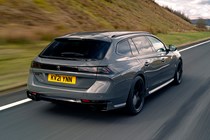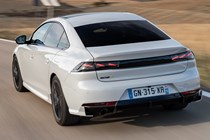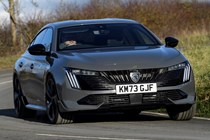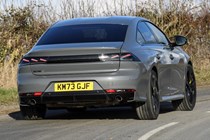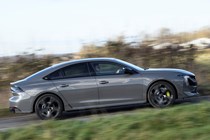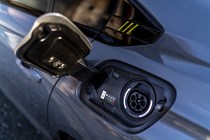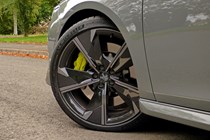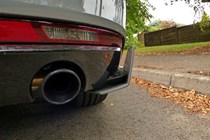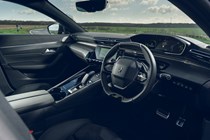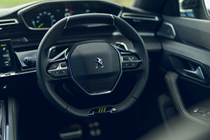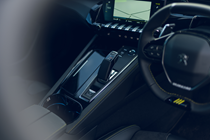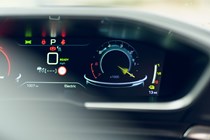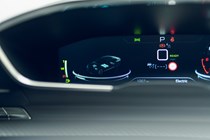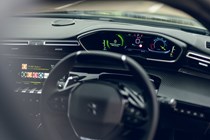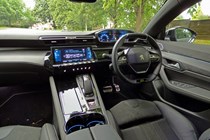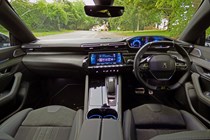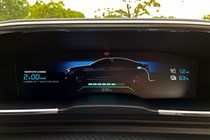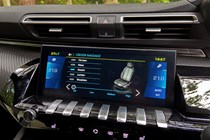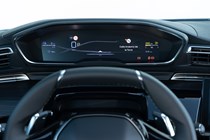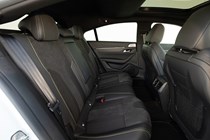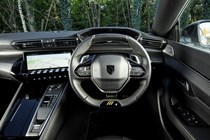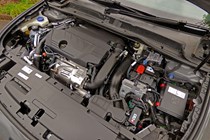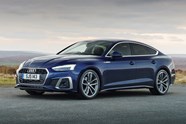
Peugeot 508 Peugeot Sport Engineered (2021-2024) review
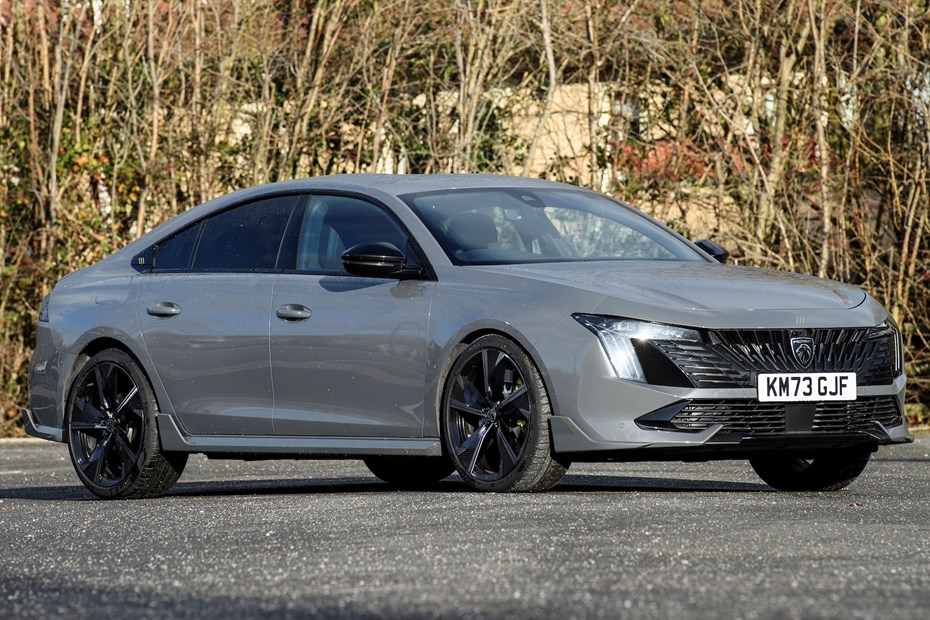
At a glance
| Price new | £53,975 - £54,925 |
|---|---|
| Used prices | £16,165 - £31,135 |
| Road tax cost | £620 |
| Insurance group | 41 |
Get an insurance quote with

|
|
| Fuel economy | Not tested to latest standards |
| Number of doors | 5 |
| View full specs for a specific version | |
Available fuel types
Hybrid
Pros & cons
- PHEV allows for low running costs
- Impressive performance in Sport mode
- Comfortable long distance cruiser
- Needs a full battery for best experience
- Expensive to buy privately
- Battery range is tiny
Peugeot 508 Peugeot Sport Engineered (21-24) rivals
Overview
The Peugeot 508 Peugeot Sport Engineered (or 508 PSE) might not have flown off the shelves since its launch in 2021, but the eye-catching five-door coupe (and estate) is unusual for being a plug-in hybrid that’s been honed as the firm’s all-out performance model.
It’s been facelifted for 2023, which means subtle tweaks to the styling with a new, more aggressive grille and slimmer headlamps, and an updated infotainment system. Peugeot is working hard to up its image in the UK, and hopes that the revised 508 car will do the business.
It’s certainly a difficult car to pin down in terms of rivals, because although few Brits would ever consider Peugeot a premium manufacturer, the pricing and performance of the PSE put it up against cars that wear some very smart badges indeed. So, you’ll find it on the same shopping list as BMW 4 Series Gran Coupe, Audi A5 Sportback as well as the Jaguar XE – none of which are performance plug-in hybrids.
The 508 PSE is the most expensive car Peugeot has sold. But for all that wedge, you get a 360hp plug-in hybrid performance car with eyecatching looks, motor sport-honed ride and handling, and excellent tax efficiency rolled up in a potentially cheap-to-fuel package. With 20-inch alloy wheels, lowered sports suspension and some subtle aerodynamic additions, it really stands out in the company car park.
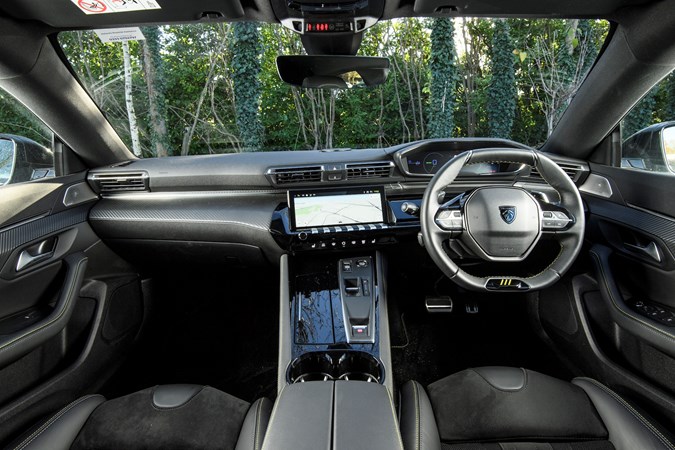
What’s it like inside?
The 508 PSE’s interior remains, as with the standard 508, an acquired taste. That’s due in the main part to its unusual layout – one that Peugeot terms ‘i-Cockpit’. For the facelift, changes have been kept to a minimum, so you get an updated infotainment set-up and some new trim options for this sporting five-door coupe.
Most controversial aspect of the 508 PSE is its shrunken steering wheel and raised dials. It forces you to adopt a driving position that for some will feel as though the wheel’s in their lap. It takes some getting used to, and it’s often taller drivers who report the most concerns. A test drive is essential to ensure you get on with this arrangement, but don’t be afraid to play around with the driving position.
The PSE tweaks have given the 508 some rather lovely massaging sports seats, which are set lower than the standard items and really hug your body well, supporting you in the corners. Grippy Alcantara upholstery helps here too, though it would be nice if this extended to the steering wheel which is shod in the same slightly slippery leather as the regular car.
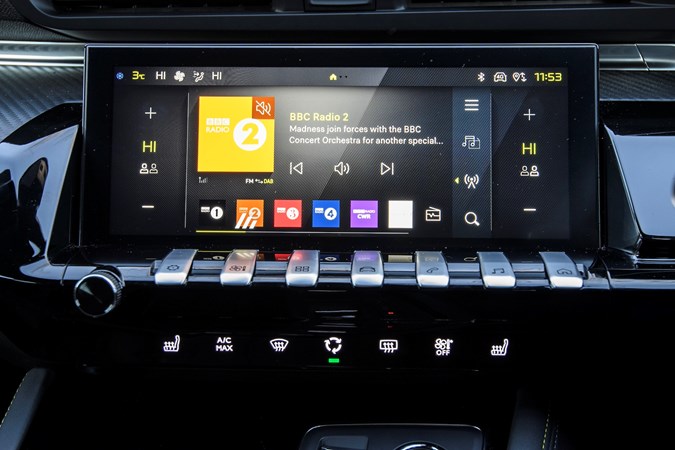
The 508 is now equipped with Peugeot’s latest digital dial pack as found on the 208 hatchback and 2008 SUV. It looks slicker than before, and is visually very appealing, even if the displays are less configurable than some of its rivals. Looking across to the 10.0-inch infotainment screen and you’ll be greeted by a similar visual update, with nicer fonts and colours and decent Apple CarPlay integration. The twin rows of quick keys below are unsatisfying to use, and we’d welcome a physical controller for the heater.
Everything else inside is similar to the standard 508, which means you get adequate space up front but a very tight rear seat in terms of leg and headroom. The boot is large, though, relatively unsullied by the hybrid additions and accessed through a huge, wide-opening tailgate. In short, think of it as a conventional coupe with better rear access, and not a conventional family car, and you won’t be too disappointed.
What’s it like to drive?
The 508 PSE uses a 200hp 1.6-litre petrol engine up front, as well as an electric motor on each axle. This gives the car a total of 360hp, mostly sent via an eight-speed automatic gearbox to the front wheels while the electric rear motor endows it with four-wheel drive when needed. This is unchanged over the pre-facelift car.
At the start of every journey the 508 PSE defaults into electric mode, and there’s really very little to dislike about it. The two electric motors have plenty of power (front: 110hp, rear: 113hp), as well as the instantaneous response and silent operation of all electric cars. Most plug-in hybrids make do with just a single electric motor and can feel quite lethargic in full electric mode, whereas the 508 PSE feels quick on its feet.
There are four driving modes – Comfort, Hybrid, Sport and 4WD. It’s Comfort and Sport you’ll probably be using most of the time as these are very well-judged for regular driving when you need to and having some fun when you can.
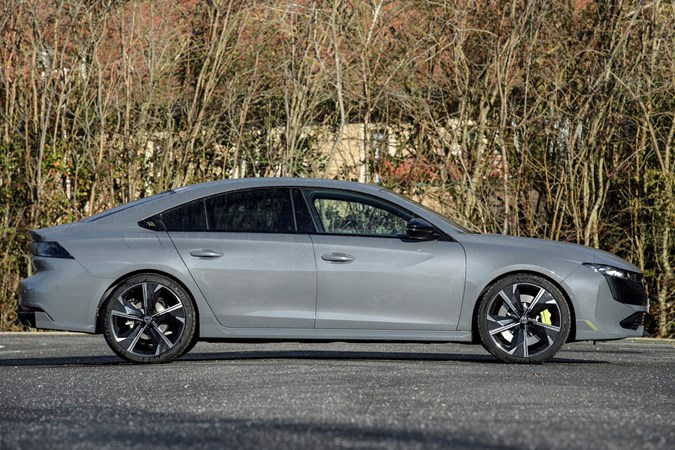
Of course, the 508 PSE’s real appeal is to be found in Sport mode. The combined power output is best sampled here, especially from low speeds, as the 508 leaps off the line, sprinting from 0-62mph in just 5.2 seconds and storming on to a top speed of 155mph. It’s not quite so urgent in the mid-range but you have plenty of effortless performance, provided the battery has enough charge.
The switch between power sources is mostly unobtrusive, with the transition often not being felt at all. The systems can still trip over themselves in stop-start traffic, though, depending on the modes you’re using, leading to a clunky experience as they struggle to decide whether to keep the petrol engine running or not. But not too noticeable.
Once the battery is depleted and the petrol engine solely propels all this weight, there’s a distinct lull in performance, especially if you decide to charge the battery in e-Save mode at the same time. The engine also gets rather vocal if revved out, with a reedy, unsatisfying soundtrack.
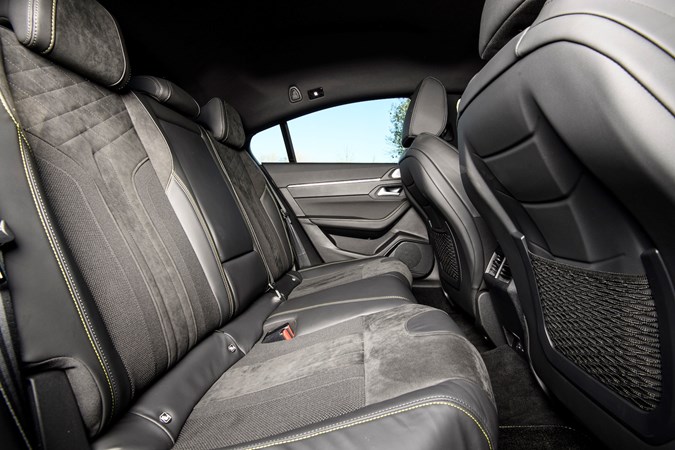
Handling
The standard 508 already feels agile when compared to its rivals and this PSE model retains some of the agility rather well, despite the added weight. Adaptive dampers and upgraded brakes and tyres all look very impressive on paper. With quick, effortless steering and a degree of compliance from the chassis, there’s genuine talent here. There’s also plenty of grip.
Introduce a few slower, tighter corners and a few weaknesses start to show. The steering is too light to be involving, even in Sport mode, with very little indication of grip levels, and you can find yourself realigning the vehicle’s position under heavy braking. The 508 PSE can be fun, but it’s hard to ignore the BMW 330e‘s far more polished dynamics.
The 508 PSE is otherwise relaxing to drive, aided by a ride that, while firm, is well-judged for less-than-perfect roads. Only in the firmest Sport mode will you notice thumps being sent into the cabin.
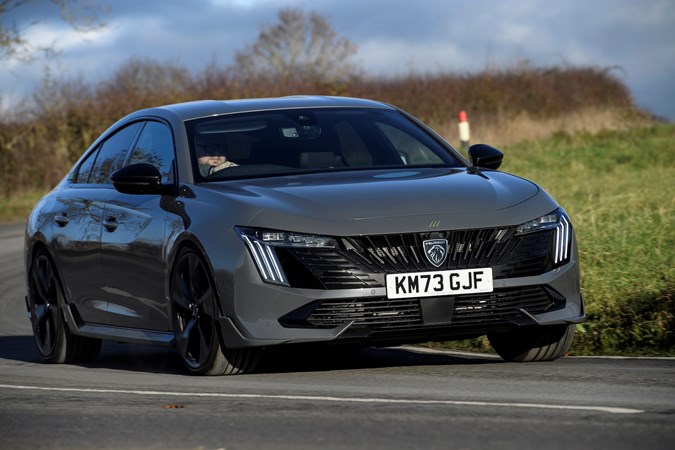
Range and charging
The key appeal of a plug-in hybrid performance car is that when you need to use your vehicle for less glamorous pursuits – school runs, supermarket trips, or even a traffic-laden daily commute – noise-free electric motoring is just a button-press away.
Peugeot claims the 508 PSE will cover 34 miles on battery power alone, which is at the lower end of what we’d consider useful. In the real world, that’s likely to be around 25 miles on a good day, and that seems like you’re starting on the back foot when you consider the BMW 330e will easily cover 30 miles before needing to be plugged in.
Charging the 508’s small 12.4kWh is comparatively quick, though. A standard three-pin domestic socket will give you a full charge in seven hours, so plugging in overnight is easily done. The 508 also supports 7.4kW charging from a home wallbox or public charger, where a full charge takes 1hr 45 minutes.
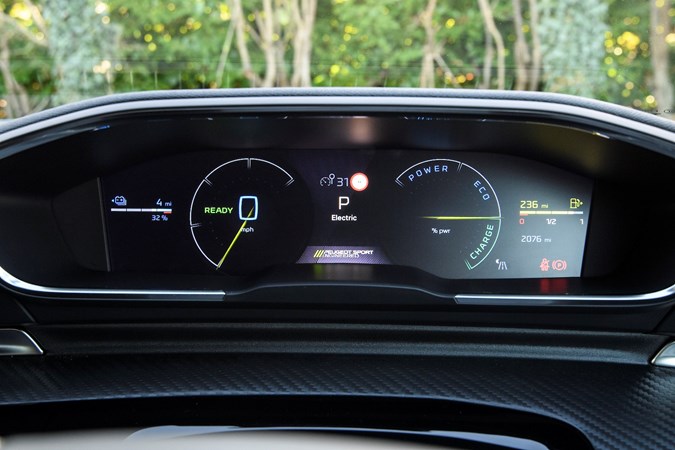
Your charging habits will very much affect your fuel economy, which according to official tests is a scarcely-believable 158mpg or so. Clearly, the more you charge and use electric power, the less petrol you’ll burn.
Make the most of the 508 PSE’s ample performance and fuel economy will tumble. In the pre-facelift car we’ve seen around 30mpg after a 160-mile day of mixed roads that made full use of the performance available, starting with a fully-charged battery and topping up halfway through the day. As a plug-in hybrid, this isn’t exactly impressive, but not a bad result considering the performance on offer.
On a more typical day with a mixture of motorway cruising, town driving and country roads, we managed 44mpg in Hybrid mode, dropping down to mid- to high-30s if we used the e-Save function. This allows you to charge the battery on the go, with individual settings for you to have a minimum reserve of six, 12 or 26 miles. This is best treated as a backup and for emergency use, though, as it really chomps through petrol.
What will it cost to run?
There’s no getting away from the fact the Peugeot 508 PSE is a pricey car. With lofty price tag and finance plans that are correspondingly juicy, this is a really tough sell for private buyers. As a company car it makes a lot more sense, thanks to very favourable rates for plug-in hybrids. With CO2 output of 40g/km, it sits in the 13% BIK band.
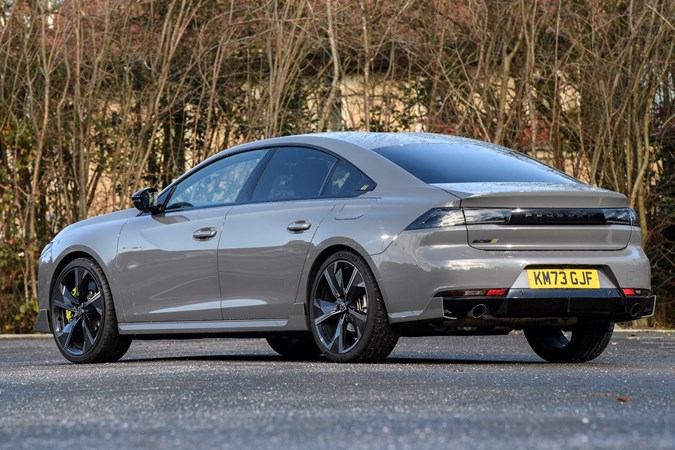
What models and trims are available?
There’s just one PSE available in fastback and estate car forms. It’s worth noting Peugeot includes loads of equipment – sadly the more interesting paint colours of the original car have now been dropped, so your only choices are white, silver and grey. As standard you get 20-inch alloy wheels, three suspension modes – Comfort, Normal, Sport – and driver assistance systems that include Night Vision (infra-red display of the road ahead on the instrument screen), adaptive cruise control and lane positioning assistance.
We are also impressed by the standard fit Focal sound system’s quality, and how effective the matrix LED active headlamps are on unlit roads. The infotainment set-up gets wireless phone charging, connected services (for online traffic updates), and Tom Tom sat-nav for those who don’t use Apple CarPlay or Android Auto. Spec a (slower) BMW 330e up to a similar level and you won’t see much difference in price between the two.
As for day-to-day running costs, fuel economy will depend on your charging behaviour as mentioned earlier. The low first year tax figure gives way to a hefty supplement for the following five years, due to the car’s list price.
So should you choose one over a premium-badged rival from Germany – or has Peugeot done enough to convince you to try something less conventional? Read on for our verdict.



